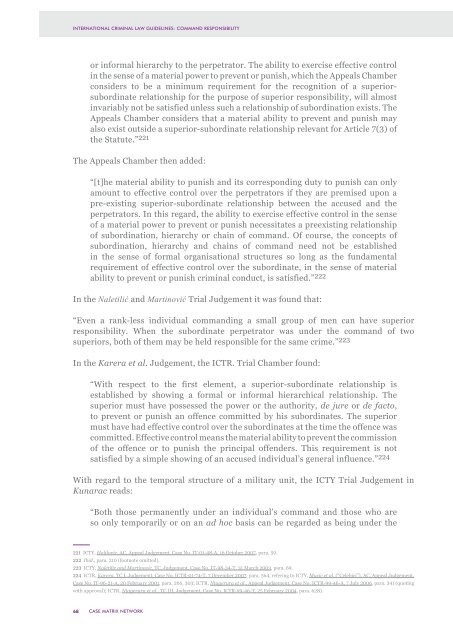Command Responsibility
CMN_ICL_Guidelines_Command_Responsibility_En
CMN_ICL_Guidelines_Command_Responsibility_En
You also want an ePaper? Increase the reach of your titles
YUMPU automatically turns print PDFs into web optimized ePapers that Google loves.
INTERNATIONAL CRIMINAL LAW GUIDELINES: COMMAND RESPONSIBILITY<br />
or informal hierarchy to the perpetrator. The ability to exercise effective control<br />
in the sense of a material power to prevent or punish, which the Appeals Chamber<br />
considers to be a minimum requirement for the recognition of a superiorsubordinate<br />
relationship for the purpose of superior responsibility, will almost<br />
invariably not be satisfied unless such a relationship of subordination exists. The<br />
Appeals Chamber considers that a material ability to prevent and punish may<br />
also exist outside a superior-subordinate relationship relevant for Article 7(3) of<br />
the Statute.” 221<br />
The Appeals Chamber then added:<br />
“[t]he material ability to punish and its corresponding duty to punish can only<br />
amount to effective control over the perpetrators if they are premised upon a<br />
pre-existing superior-subordinate relationship between the accused and the<br />
perpetrators. In this regard, the ability to exercise effective control in the sense<br />
of a material power to prevent or punish necessitates a preexisting relationship<br />
of subordination, hierarchy or chain of command. Of course, the concepts of<br />
subordination, hierarchy and chains of command need not be established<br />
in the sense of formal organisational structures so long as the fundamental<br />
requirement of effective control over the subordinate, in the sense of material<br />
ability to prevent or punish criminal conduct, is satisfied.” 222<br />
In the Naletilić and Martinović Trial Judgement it was found that:<br />
“Even a rank-less individual commanding a small group of men can have superior<br />
responsibility. When the subordinate perpetrator was under the command of two<br />
superiors, both of them may be held responsible for the same crime.” 223<br />
In the Karera et al. Judgement, the ICTR. Trial Chamber found:<br />
“With respect to the first element, a superior-subordinate relationship is<br />
established by showing a formal or informal hierarchical relationship. The<br />
superior must have possessed the power or the authority, de jure or de facto,<br />
to prevent or punish an offence committed by his subordinates. The superior<br />
must have had effective control over the subordinates at the time the offence was<br />
committed. Effective control means the material ability to prevent the commission<br />
of the offence or to punish the principal offenders. This requirement is not<br />
satisfied by a simple showing of an accused individual’s general influence.” 224<br />
With regard to the temporal structure of a military unit, the ICTY Trial Judgement in<br />
Kunarac reads:<br />
“Both those permanently under an individual’s command and those who are<br />
so only temporarily or on an ad hoc basis can be regarded as being under the<br />
221 ICTY, Halilovic, AC, Appeal Judgement, Case No. IT-01-48-A, 16 October 2007, para. 59.<br />
222 Ibid., para. 210 (footnote omitted).<br />
223 ICTY, Naletilic and Martinovic, TC, Judgement, Case No. IT-98-34-T, 31 March 2003, para. 69.<br />
224 ICTR, Karera, TC I, Judgement, Case No. ICTR-01-74-T, 7 December 2007, para. 564, refering to ICTY, Mucic et al. (“Celebici”), AC, Appeal Judgement,<br />
Case No. IT-96-21-A, 20 February 2001, para. 266, 303; ICTR, Ntagerura et al., Appeal Judgement, Case No. ICTR-99-46-A, 7 July 2006, para. 341 (quoting<br />
with approval); ICTR, Ntagerura et al., TC III, Judgement, Case No. ICTR-99-46-T, 25 February 2004, para. 628).<br />
68<br />
CASE MATRIX NETWORK


